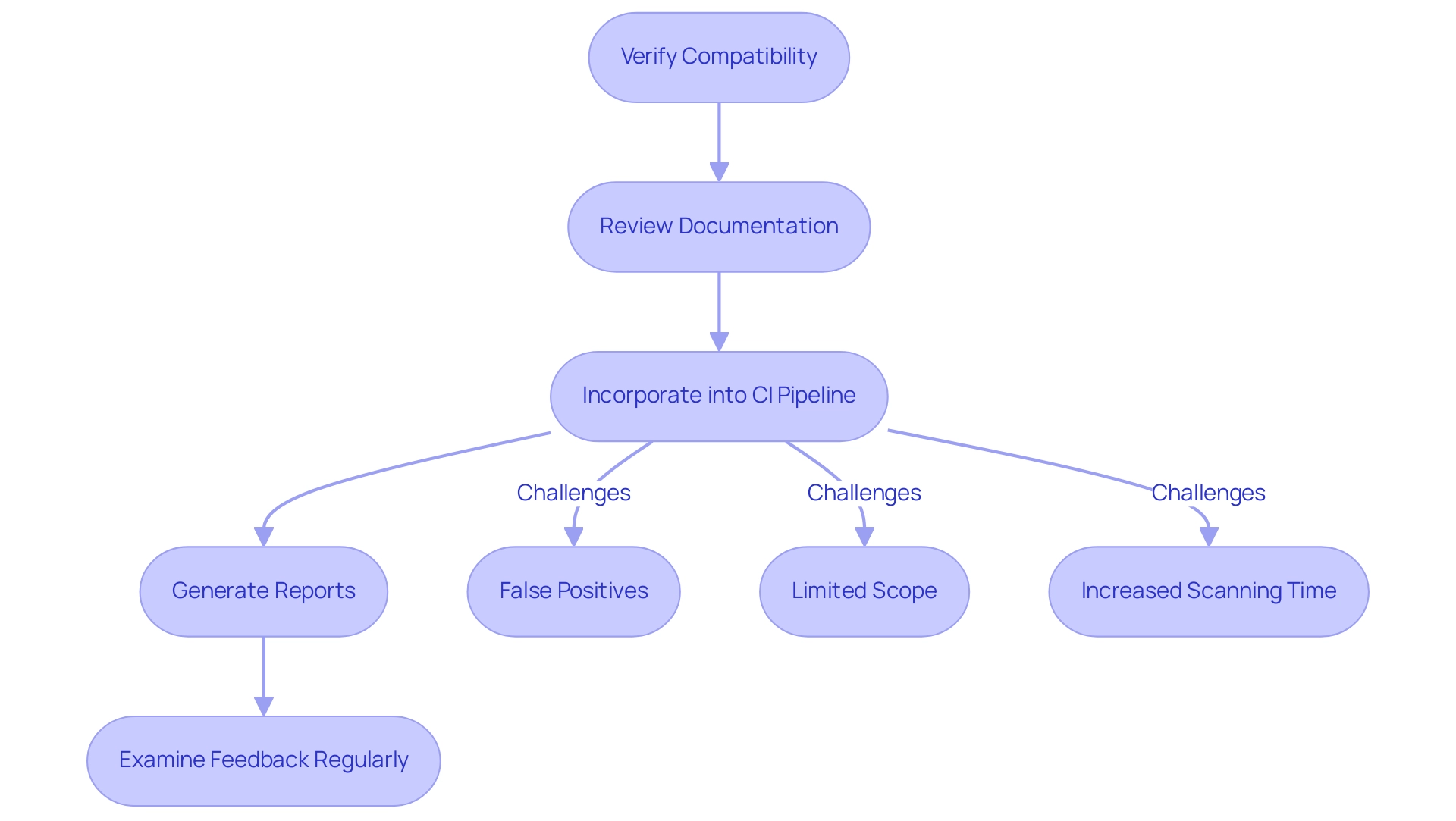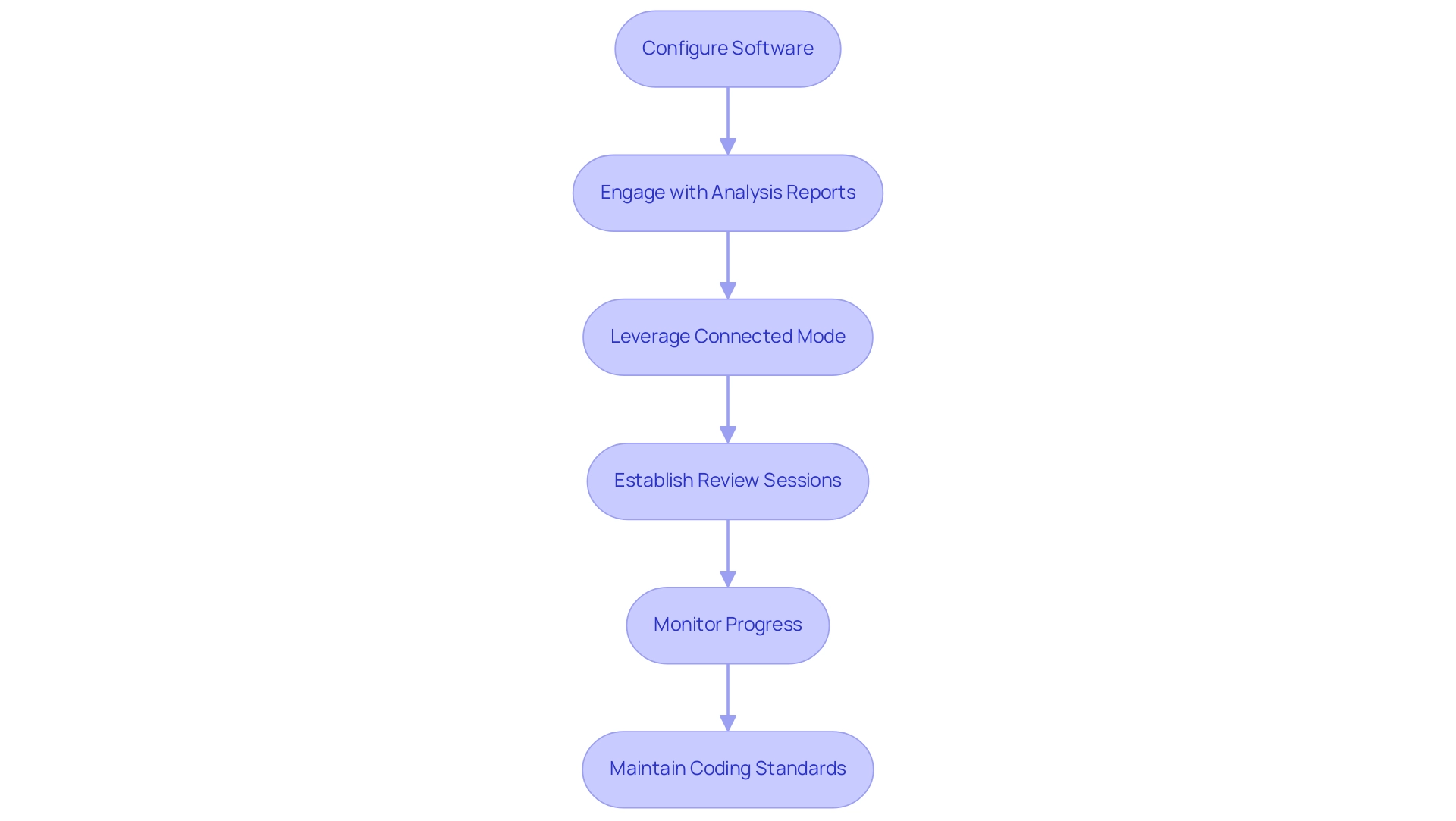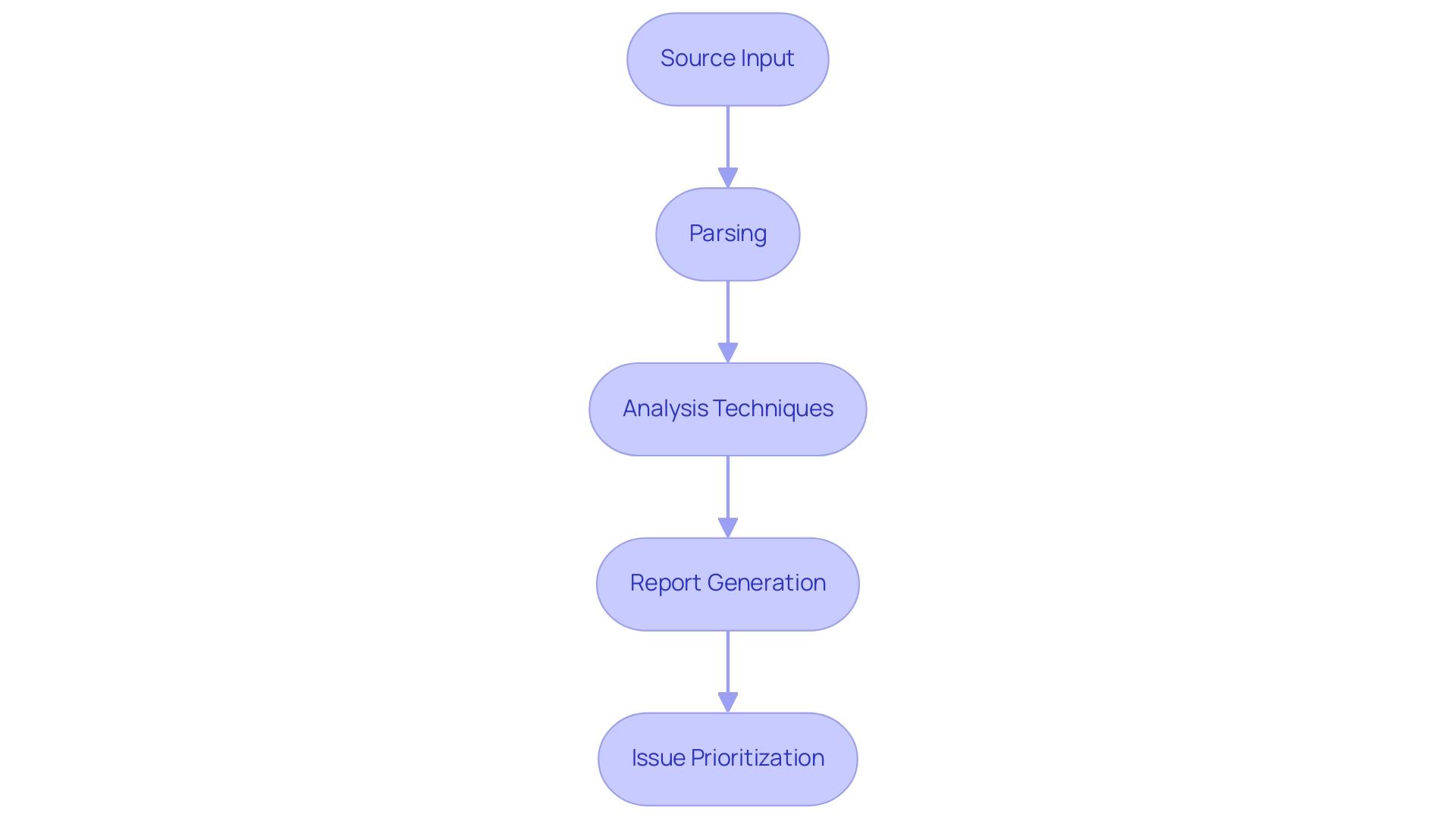Introduction
In the fast-evolving landscape of software development, maintaining high code quality is not just an option; it's a necessity. As teams strive for efficiency and reliability, tools like Kodezi CLI emerge as essential allies in the quest to identify and rectify vulnerabilities, bugs, and code smells before they escalate into significant issues. By seamlessly integrating automated code reviews into the development workflow, Kodezi empowers developers to enhance performance, ensure security compliance, and foster a culture of continuous improvement.
This article delves into the multifaceted benefits of Kodezi, exploring how its features can transform coding practices and drive productivity, all while adhering to the latest industry standards. With a focus on best practices and overcoming common challenges, the insights provided will equip teams to leverage Kodezi effectively, ensuring their codebases remain robust and reliable in an increasingly complex digital environment.
Understanding Code Sonar: Purpose and Benefits
Kodezi CLI emerges as a crucial resource in program management, significantly enhancing quality through proactive identification of security vulnerabilities, flaws, and design issues. By integrating Kodezi CLI into your development workflow, you enable automated reviews that pinpoint potential issues before they escalate into critical problems. This instrument supports a diverse range of programming languages and frameworks, seamlessly adapting to various project requirements.
With its ability to instantly identify and fix codebase issues, Kodezi CLI empowers developers to enhance performance by addressing bottlenecks, ensuring security compliance, and adding exception handling where needed. Moreover, it provides detailed explanations and insights into what went wrong and how it was resolved, aiding in the learning process for developers. Its comprehensive analysis not only enhances maintainability but also plays a crucial role in ensuring that the codebase complies with the latest security best practices and programming standards, ultimately driving team productivity and ensuring reliability.
A recent study highlighted the prevalence of undetected vulnerabilities, emphasizing the necessity of resources like Code Sonar in modern software development. By leveraging its capabilities for automated debugging and code enhancement, teams can significantly elevate their code quality, leading to more efficient and effective software solutions. Moving forward, the focus on enhancing automated tools for undetected vulnerabilities remains a critical area for future development in the industry.
Integrating Code Sonar into Your Development Workflow
To effectively incorporate this tool into your development process, begin by verifying compatibility with your current environment. Review the official documentation to confirm that your project meets the necessary requirements. Once compatibility is established, incorporate Code Sonar into your Continuous Integration (CI) pipeline to enable automatic analyses with every commit.
This integration not only streamlines the process but also promotes immediate feedback on code quality. However, it is essential to be aware of the challenges associated with integrating SAST tools, such as:
- The potential for false positives
- Limited scope of assessment
- Increased scanning time, which can disrupt development workflows
Set up the tool to generate insightful reports that are easily shareable among team members, fostering collaborative discussions on improvements.
Establish it as a regular practice to routinely examine and respond to the feedback from Code; this proactive method not only improves quality but also fosters a culture of reliability within your team. Altay Ataman highlights this aspect effectively:
Frequently utilizing static analysis resources will enhance quality and reliability.
Additionally, organizations that successfully utilize resources such as software analysis can decrease security weaknesses in their programming by as much as 30%, highlighting the concrete advantages of incorporating such resources into everyday processes.
Additionally, consider Klocwork's differential analysis, which has proven effective with internal cloud computing resources like OpenStack, as well as customization features provided by solutions like Bearer CLI, which can generate privacy reports and data flows, further enhancing your CI/CD pipeline.

Key Features of Code Sonar for Enhancing Code Quality
Code sonar is equipped with several pivotal features engineered to significantly elevate quality, which is essential for efficiency enthusiasts in modern agile development. The advanced static analysis capabilities provided by code sonar are instrumental in detecting potential vulnerabilities and coding errors, ensuring developers can catch issues early in the development cycle. Automated debugging allows for rapid issue resolution, helping teams optimize performance and maintain security compliance, which is crucial in today's software landscape.
According to industry statistics, organizations that implement static analysis tools can reduce programming errors by up to 30%, thereby adhering to predefined standards and ensuring quality. The robust reporting functionality offers detailed insights into code smells and maintainability challenges, utilizing code sonar to empower teams to prioritize fixes based on severity and impact. For instance, this software offers clear explanations of the root causes of identified problems, enabling developers to understand not only what is wrong, but also why it is a concern and how to resolve it efficiently.
Notably, code sonar's seamless integration with various issue trackers simplifies the management of identified problems, streamlining workflows and enhancing productivity. Additionally, the use of code sonar to visualize code dependencies provides a clear understanding of how changes affect the overall codebase, fostering improved coding practices. For instance, a case study on JavaScript Static Analysis with ESLint demonstrated how the resource identified issues like incorrect string quotation and unused variable assignments, ultimately enhancing the reliability of software.
By harnessing these features, including Kodezi's AI-driven automated builds and testing, developers can ensure compliance with industry standards and best practices, leading to improved software quality and a more efficient development process. Furthermore, code sonar actively enforces adherence to the latest security best practices and coding standards, acting as an essential audit mechanism that helps teams meet stringent security benchmarks. Embracing a shift-left strategy can result in enhanced customer satisfaction and lowered development expenses, as Codacy highlights, especially in areas where software must comply with strict security standards, underscoring the importance of these resources as a vital audit mechanism.
Best Practices for Effective Use of Code Sonar
To maximize the benefits of code sonar, it is essential to regularly configure the software to align with your project's specific coding standards and requirements. As Jura Gorohovsky states, "This guide was written by Jura Gorohovsky," emphasizing the importance of expert guidance in utilizing such tools effectively. Encourage team members to actively engage with the analysis reports, viewing them not merely as compliance checks, but as valuable resources for learning and enhancement.
By leveraging the Connected Mode in SonarQube for IDE, teams can unlock advanced capabilities when paired with the SonarQube Server, further enhancing their quality efforts. Establish routine quality assessment review sessions to facilitate collaborative discussions around the findings from the analysis tool, allowing teams to address issues collectively. It is critical to note that if vulnerabilities exceed 25, the quality gate will fail, underscoring the importance of maintaining high coding standards.
Additionally, utilize the software to monitor progress over time by comparing reports, allowing teams to assess the impact of their optimization efforts. This approach fosters a culture of quality and continuous improvement, ultimately enhancing coding standards and team performance.

Overcoming Challenges in Using Code Sonar
While code sonar offers significant advantages for enhancing code quality, developers often encounter challenges, particularly with false positives in analysis reports and the complexity of interpreting results. Notably, this topic has garnered considerable attention, as evidenced by the fact that the question has been viewed 1,000 times. A recent observation highlights that static analysis methods, particularly in legacy codebases, can yield numerous false positives, which can detract from their effectiveness.
To counter this, it is essential to regularly update the software and refine its configuration to better align with your specific coding practices. For instance, teams can effectively reduce false positives by adjusting the settings of the application to match their development context, as noted by industry experts:
- A lot of this depends on the context of the software – a Jupyter notebook with an explorative data science session will have completely different quality requirements from a business-critical financial system.
Furthermore, the efficient application of static analysis tools necessitates skilled programmers who can analyze results critically, highlighting the significance of expertise in optimizing the advantages of the software.
When confronting intricate reports, collaboration among team members can prove invaluable in interpreting findings and prioritizing issues based on severity. The process of static source analysis involves several stages, beginning with source input and followed by parsing and various analysis techniques, ultimately generating reports on identified issues and suggested fixes. Investing in training sessions to improve the team's comprehension of the software's features and best practices is also essential.
By fostering a collaborative and supportive environment, teams can successfully navigate these challenges and utilize Code Sonar to its full potential, ultimately enhancing code quality and efficiency.

Conclusion
Integrating Kodezi CLI into the software development process is a transformative step towards achieving exceptional code quality and team productivity. By automating code reviews, Kodezi empowers developers to identify and address vulnerabilities, bugs, and code smells before they become significant issues. This proactive approach not only enhances performance but also ensures compliance with the latest security standards, fostering a culture of continuous improvement within development teams.
The multifaceted features of Kodezi, from its advanced static analysis capabilities to its robust reporting functionalities, provide valuable insights that help teams prioritize fixes and streamline workflows. Regularly leveraging these tools, alongside best practices such as routine code quality reviews and collaborative discussions, cultivates an environment where coding standards are consistently upheld. As organizations embrace these practices, they can expect to see a marked reduction in coding errors and security vulnerabilities, ultimately leading to more reliable and efficient software solutions.
In a rapidly evolving digital landscape, the necessity of maintaining high code quality cannot be overstated. By harnessing the capabilities of Kodezi, development teams are not only equipped to tackle current challenges but are also positioned to adapt to future demands, ensuring their codebases remain robust and secure. Embracing tools like Kodezi is essential for any team aiming to thrive in today’s competitive software development environment.
Frequently Asked Questions
What is Kodezi CLI and its primary purpose?
Kodezi CLI is a tool that enhances program management by proactively identifying security vulnerabilities, flaws, and design issues in code. It enables automated reviews to pinpoint potential problems before they escalate.
How does Kodezi CLI improve code quality?
Kodezi CLI instantly identifies and fixes codebase issues, enhances performance by addressing bottlenecks, ensures security compliance, and adds exception handling where necessary. It also provides detailed explanations of issues and their resolutions, aiding developer learning.
What programming languages and frameworks does Kodezi CLI support?
Kodezi CLI supports a diverse range of programming languages and frameworks, allowing it to adapt seamlessly to various project requirements.
What are the benefits of integrating Kodezi CLI into the development workflow?
Integrating Kodezi CLI allows for automated reviews, enhances maintainability, ensures compliance with security best practices, drives team productivity, and ultimately improves the reliability of the codebase.
What challenges might arise when integrating SAST tools like Kodezi CLI?
Challenges include the potential for false positives, limited scope of assessment, and increased scanning time, which can disrupt development workflows.
How can teams effectively incorporate Kodezi CLI into their development process?
Teams should verify compatibility with their environment, review official documentation, and incorporate Kodezi CLI into their Continuous Integration (CI) pipeline for automatic analyses with every commit.
What is the importance of generating reports from Kodezi CLI?
Generating insightful reports fosters collaborative discussions among team members about improvements and helps establish a culture of reliability within the team.
How can regular use of static analysis resources improve programming quality?
Frequently utilizing static analysis resources can enhance quality and reliability, potentially decreasing security weaknesses in programming by as much as 30%.
What other tools are mentioned that can complement Kodezi CLI?
Klocwork's differential analysis and customization features from Bearer CLI, which can generate privacy reports and data flows, are mentioned as effective tools to enhance the CI/CD pipeline.




